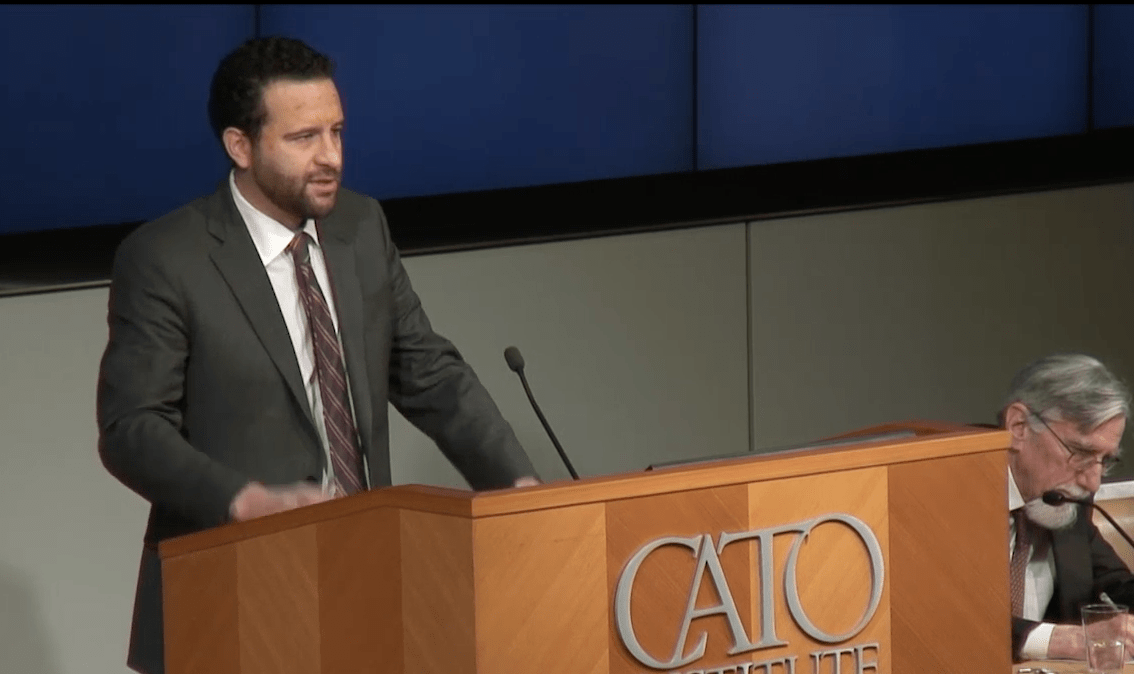William Wohlforth
WILLIAM WOHLFORTH: Steve and I have been partners in crime as coauthors for some 20 years now, and I’d say for at least 15 of those 20 years, we have been debating a group of highly intelligent scholars of international relations who believe the United States should pull back, retrench, cut a much smaller figure on the international scene than it has generally done since 1950. After a long while, we finally decided to write about what we would actually do if we were responsible for the affairs of this country.
The book answers what Steve and I think are two of the most important questions, if not the most important questions, facing the United States in the 21st century. The first question is, does the United States have the material capacity to continue to sustain a strategy of deep engagement with the world? Or is it soon going to decline in terms of its power position, to the point where we’ll no longer have the capacity to act as a superpower?
The first part of the book takes a deep dive into the numbers, but I won’t bore you with the details, I’ll simply come to our essential finding: that the world has changed in ways to render the rise of new challengers to an existing great power like the United States much more difficult than in the past. The complexity, the scale of investments necessary to create the military systems, platforms, infrastructure, and software that sustain the United States’ position are things that are only the result of decades of investment, and it’s very, very hard to catch up. The one country that really has, at least in the broad sense, the capacity to either become a superpower or render the United States incapable of being one is China. And that country is far behind the United States technologically. Indeed, the gap between the rising and defending power of the current global order is larger in this technological realm than in all the canonical cases of rise and decline of powers in the world, such as the rise of Germany, the rise of the United States itself in the 19th and early 20th centuries, and the rise of the Soviet Union in the middle of the 20th century. We believe that it’s going to be many decades before the United States would be compelled by its circumstances to cease pursuing this grand strategy of deep engagement.
Which leads, of course, to the second key question: should the United States continue to pursue this strategy just because it can? And to answer that question, I invite my colleague Steve Brooks up to the stage.
Stephen Brooks
STEPHEN BROOKS: The bulk of our book, America Abroad, is devoted to analyzing what the world would look like if the United States no longer pursued a global leadership role. Today, let me make five overall points. The first overall point is that many people who critique the deep engagement grand strategy misinterpret it because they do not focus on its constant defining elements. So what are those constant defining elements? Let me first talk about what they are not. Is active democracy promotion a defining element? We would say no. Is assertive human rights promotion a defining element? We would say no. Is the regular use of military power a defining element? We would say no. What ultimately lies at the core of deep engagement are three objectives: first, managing the external environment to reduce near- and long-term threats to U.S. security; second, promoting a liberal economic order, to expand the global economy and maximize U.S. prosperity; and third, creating, sustaining, and revising the global institutional order to secure necessary interstate cooperation to advance American interests. Those three objectives have been constant elements of U.S. grand strategy for 70 years. And the pursuit of those objectives underlies what is arguably the United States’ most consequential strategic choice, which is to maintain security partnerships with allies in three core regions: Europe, East Asia, and the Middle East.
Our second overall point is that the costs and risks of deep engagement are manageable. The scholarly proponents of retrenchment advance a powerful set of arguments for why deep engagement is costly and risky, and they point to five things in particular: free riding — if we defend our allies they spend less; entrapment — our allies might pull us into a war that’s not in our interest; budgetary costs — we’re spending all this money on defense that we could be using here at home; balancing — we make other countries mad, or madder, than they would otherwise be; and finally temptation, which is the “if you have a hammer, then everything looks like a nail” problem — this constant temptation to do something, given all of the material power that we have.
In the book we went through and addressed all of these counterarguments in detail. We think they’re serious, and by far the strongest of them is the temptation argument. As for the free riding, entrapment, and budgetary cost arguments, they obtain, but weakly in our view. Regarding free riding, sure, our allies free ride. But it’s less than you think, if you consider all the things that our allies do instead of boiling down the metric of judging our allies to one thing, which is how much they spend on defense. For example, when is the last time Germany voted against us in the International Monetary Fund? That kind of support matters.
Regarding entrapment, it’s a real risk, but as Tufts University’s Michael Beckley shows in his study on entangling alliances, this is a risk the United States has so far essentially avoided. And you must also balance that risk against the risk that, if a conflict emerges and we get pulled back into a region, it’s going to be more costly than being there in the first place to prevent the conflict. Summing up, there are certainly costs and risks of deep engagement, but they are manageable.
Our third overall point is that security provided from the outside by the United States is more likely to produce stability in these three core regions than if security were provided by local actors. We outline the many reasons this is the case in the book.
Our fourth overall point is that academic proponents of retrenchment, in general, miss many of the benefits of deep engagement. The analysis of grand strategy cannot be limited just to security affairs. But that is just what the vast majority of proponents of retrenchment do, and they consequently miss the large economic and institutional benefits of deep engagement.
Finally, pulling back from the world would be a very risky grand experiment that is simply not worth running. The world is not perfect for America’s interests. We just think things would be even worse if the United States pulled back.
Eugene Gholz
EUGENE GHOLZ: This book is a very meaningful contribution, but it presents no theory of the causes of war or the causes of threat. The chapter that outlines the book’s intellectual underpinnings talks about the role of deterrence and the role of assurance, which are important concepts. But proponents of restraint believe in deterrence, too. So the authors are not doing a good job of creating an underpinning architecture of what makes their sense of what causes conflict in the world different from what I think. And I think that, implicitly, their argument rests on what academics call hegemonic stability theory — that you can overwhelm the rise of potential challengers by making a strong commitment to providing global security. We’ll tell people what to do, but we’re nice guys so they won’t be too upset about it, and that will resolve the causes of war or threat. That’s what their argument really builds on, but they don’t actually say that, and it’s telling.
The trouble is, that overall argument that says the world is a more peaceful place when there is one powerful country that keeps security competition down is actually quite weak in academia. You can’t do a systematic, careful, theoretical review of the academic evidence in favor of hegemonic stability theory, because it just sort of petered out in the late 1980s or 1990s, because people couldn’t figure out how to make the case for it. It’s a weak intellectual case, and they really need to fix that to make their argument believable. If we want to prevent the causes of war, why do we think having one strong power actively engage with the world addresses the problem of rising threats?
As they bolster the case for deterrence, since what they believe they’re doing with deep engagement is deterring threats around the world, they actually make a case which is very helpful to the restraint case. They argue that deterrence is easier than compellence — that if the United States is helping deter threats to Japan, that’s an easier job than coming back later and trying to chase away dangers. But, of course, if deterrence is relatively easy, countries can deter on their own behalf — they don’t need the United States.
You have to ask yourself, what does the United States have to do to convince other countries that we’re serious about extending our deterrent envelope to protect others? We have to show people we’re a little bit crazy, that we’re willing to fight, and pay real costs, to fight wars for other countries, not for ourselves. And that’s the real danger — that we fight extra wars. It’s not that Germany entraps us into fighting on their behalf, but that we willingly fight on Germany’s behalf because we’re trying to convince not only Germany but also Japan and also Taiwan and also Korea and all of our other dependencies around the world that we’re crazy enough to fight on their behalf also. Basically we have to convince people that we like to fight. And that’s costly.
Bill and Steve say over and over again that there is no temptation problem in true deep engagement to do democracy promotion, or to do humanitarian interventions. But that’s not the temptation I’m talking about. The temptation I’m talking about is that if you define the core security, prosperity, and liberty interests of the United States the way they do, you will be tempted to fight wars and make costly commitments around the world on security grounds. So when they say that they personally opposed the Iraq War, I’m not sure why. The Iraq War was not justified on the grounds of democracy promotion. That was the ex post facto justification after we didn’t find weapons of mass destruction. But in the lead-up to the Iraq War, the argument was that Iraq posed a security threat to the United States. If deep engagement says that we care about three regions in the world, and one of them is the Middle East, we care about nuclear proliferation, we care about oil, and we believe that it’s necessary to use U.S. force to protect against nuclear proliferation and against instability in oil-producing regions of the world—based on the logic of deep engagement, how do you say no to the Iraq War? And the Iraq War was a terrible blunder, as they agree.
I think that they’ve developed a very important argument, but I think they downplay the real costs and risks, and they fail to adjust to the way the world has changed. They contort their description of the Cold War grand strategy of the United States in various ways to make it seem like deep engagement is just a continuation of fighting the Cold War, which was justified. And that’s not right. The Cold War was about resisting a particular enemy that was powerful and threatening. This is about shaping and changing the international environment and picking fights around the world. Tempting the United States to intervene over and over again.
Benjamin Friedman
BENJAMIN FRIEDMAN: I have three issues with the book. First, it focuses on critics of deep engagement who say it’s unsustainable rather than those, like me, who say the real problem is that it’s sustainably bad. Second, it ignores some non-security costs of deep engagement. Third, it understates the security dangers of deep engagement, specifically the problems of entanglement and temptation.
The book goes to great lengths to show that the costs of deep engagement are sustainable, and that switching over to restraint wouldn’t save much—at least not enough to matter a lot economically. I think the authors basically succeed in those claims, although I would point them to recent work we’ve done here at Cato, showing that we could save another trillion or so over a decade by adopting restraint. But even that, I’ll admit, would only cause the national debt to grow to $27 trillion instead of $28 trillion in the next decade. So clearly our military strategy is not going to be the solution to our fiscal troubles.
But what they don’t refute is the version of restraint that says the problem with deep engagement isn’t that it can’t be sustained, but that it can. Let me quote Stein’s Law: “If something cannot go on forever it will stop.” Our major policy problems aren’t things that are unsustainable, they’re things that we can do sustainably, to our detriment. We’re rich and powerful enough in the United States to do a lot of dumb things in our foreign policy for a long time without ruin. But that doesn’t make it a good idea, any more than being fabulously wealthy makes it a good idea to buy a fleet of 50 Lamborghinis and have an expensive drug habit.
They also ignore some of the non-security costs of deep engagement, most importantly its contribution to the damage to liberal government, which is a major, if not the major cost of deep engagement. Deep engagement harms liberal values in several ways.
First, the prospect or realization of unnecessary wars justifies the state’s restriction of various individual freedoms. That occurs not just because the state grows, and the military establishment grows and taxes more money out of people’s pockets, but also due to the direct curtailment of liberties in the name of security. Second, the supposed requirement for presidential dispatch, which results from deep engagement, boosts presidential power and saps that of Congress, the most democratic branch. This contributes to the tendency in U.S. foreign policymaking to resemble a kind of oligarchy of insiders only occasionally hindered by democratic oversight. Third, deep engagement encourages the growth of a large national security bureaucracy shrouded in secrecy, which further retards oversight and debate.
Those developments lead to generally dumber policies, because the separation of powers, where it still applies, produces conflict, which generates information about policy that empowers oversight in interest groups to the least risky and extreme policies. That moderating process generally produces policies more attuned to the national interest than those made by a largely unchecked executive. The book argues, following Michael Beckley of Tufts, that the problem of entanglement, which it defines as when a country is pulled into a conflict it would otherwise avoid because of an alliance, is rare enough to safely ignore. One problem with this is that Beckley’s short list of entanglements essentially includes Vietnam. The cost of that war alone ought to make us worry about entanglement.
Also, again relying on Beckley, the book largely defines entanglements away. Alliances meld our sense of our interest with that of our allies. That’s what George Washington was concerned about in his farewell address. That kind of entanglement doesn’t count in Beckley’s analysis, which accounts for its really low incidence. A better definition of entanglement might include the Korean War and Libya, along with Vietnam, which would show that the problem is more substantial than Brooks and Wohlforth admit.
On temptation, I appreciate the book’s admission that restraint would lessen the risks of fighting needless wars. But I’m not reassured by their alternative antidote, which includes “the emergence of prudent leadership” and the resurrection of “domestic institutional constraints on the president’s authority” to make war. I prefer the old-fashioned view that we should take seriously the possibility that the president could be a schmuck. One potential “domestic institutional constraint” on the president’s ability to start wars is the strategy of restraint and the smaller military establishment it encourages.
Finally, a note on risk. It is wrong to presume that the status quo is the careful, conservative, and risk-averse course. Of course, there are risks to adopting restraint, but the current strategy of deep engagement is riskier, thanks to its costs, the wars it encourages, and its threat to liberal values at home.



